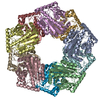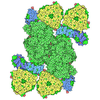[English] 日本語
 Yorodumi
Yorodumi- PDB-9kti: CryoEM structure of a 2,3-hydroxycinnamic acid 1,2-dioxygenase Mh... -
+ Open data
Open data
- Basic information
Basic information
| Entry | Database: PDB / ID: 9kti | |||||||||
|---|---|---|---|---|---|---|---|---|---|---|
| Title | CryoEM structure of a 2,3-hydroxycinnamic acid 1,2-dioxygenase MhpB in substrate bound form | |||||||||
 Components Components | 2,3-dihydroxyphenylpropionate/2,3-dihydroxicinnamic acid 1,2-dioxygenase | |||||||||
 Keywords Keywords | BIOSYNTHETIC PROTEIN / 2 / 3-hydroxycinnamic acid 1 / 2-dioxygenase | |||||||||
| Function / homology |  Function and homology information Function and homology informationphenylpropanoid catabolic process / 3-carboxyethylcatechol 2,3-dioxygenase / 3-carboxyethylcatechol 2,3-dioxygenase activity / 3-(3-hydroxy)phenylpropionate catabolic process / 3-phenylpropionate catabolic process / ferrous iron binding Similarity search - Function | |||||||||
| Biological species |  | |||||||||
| Method | ELECTRON MICROSCOPY / single particle reconstruction / cryo EM / Resolution: 2.59 Å | |||||||||
 Authors Authors | Dong, X. / Jiang, W.X. / Ma, L.X. / Xing, Q. | |||||||||
| Funding support |  China, 2items China, 2items
| |||||||||
 Citation Citation |  Journal: J Hazard Mater / Year: 2025 Journal: J Hazard Mater / Year: 2025Title: Structural and catalytic insights into MhpB: A dioxygenase enzyme for degrading catecholic pollutants. Authors: Xu Dong / Manli Xu / Miao Wu / Ying Wang / Xiaoqi Cheng / Wenxue Jiang / Dule Zheng / Ahmed Habiba Omar / Yibin Cheng / Aitao Li / Lixin Ma / Qiong Xing /  Abstract: The increasing environmental pollution from persistent aromatic compounds requires effective biodegradation strategies. In this study, we focused on MhpB, an extradiol dioxygenase (EDO) from ...The increasing environmental pollution from persistent aromatic compounds requires effective biodegradation strategies. In this study, we focused on MhpB, an extradiol dioxygenase (EDO) from Escherichia coli. It is known for its role in the degradation of catechols, key intermediates in the degradation of aromatic compounds. We report the high-resolution structure of MhpB determined by cryo-electron microscopy, revealing a decameric conformation with the catalytic chamber at the side. The structure-based analysis allowed us to investigate the substrate-enzyme interaction and the substrate selectivity, which are crucial for its catalytic function. Site-directed mutagenesis was used to modulate the in vitro and in vivo substrate preference of MhpB, enhancing its potential for industrial applications in pollutant degradation. The study provides insight into the mechanism of the enzyme and paves the way for the development of engineered EDOs for environmental remediation of aromatic pollutants. | |||||||||
| History |
|
- Structure visualization
Structure visualization
| Structure viewer | Molecule:  Molmil Molmil Jmol/JSmol Jmol/JSmol |
|---|
- Downloads & links
Downloads & links
- Download
Download
| PDBx/mmCIF format |  9kti.cif.gz 9kti.cif.gz | 536.1 KB | Display |  PDBx/mmCIF format PDBx/mmCIF format |
|---|---|---|---|---|
| PDB format |  pdb9kti.ent.gz pdb9kti.ent.gz | Display |  PDB format PDB format | |
| PDBx/mmJSON format |  9kti.json.gz 9kti.json.gz | Tree view |  PDBx/mmJSON format PDBx/mmJSON format | |
| Others |  Other downloads Other downloads |
-Validation report
| Summary document |  9kti_validation.pdf.gz 9kti_validation.pdf.gz | 2 MB | Display |  wwPDB validaton report wwPDB validaton report |
|---|---|---|---|---|
| Full document |  9kti_full_validation.pdf.gz 9kti_full_validation.pdf.gz | 2 MB | Display | |
| Data in XML |  9kti_validation.xml.gz 9kti_validation.xml.gz | 93.1 KB | Display | |
| Data in CIF |  9kti_validation.cif.gz 9kti_validation.cif.gz | 136.5 KB | Display | |
| Arichive directory |  https://data.pdbj.org/pub/pdb/validation_reports/kt/9kti https://data.pdbj.org/pub/pdb/validation_reports/kt/9kti ftp://data.pdbj.org/pub/pdb/validation_reports/kt/9kti ftp://data.pdbj.org/pub/pdb/validation_reports/kt/9kti | HTTPS FTP |
-Related structure data
| Related structure data |  62561MC  8k04C M: map data used to model this data C: citing same article ( |
|---|---|
| Similar structure data | Similarity search - Function & homology  F&H Search F&H Search |
- Links
Links
- Assembly
Assembly
| Deposited unit | 
|
|---|---|
| 1 |
|
- Components
Components
| #1: Protein | Mass: 34230.961 Da / Num. of mol.: 10 Source method: isolated from a genetically manipulated source Source: (gene. exp.)  Production host:  References: UniProt: P0ABR9, 3-carboxyethylcatechol 2,3-dioxygenase #2: Chemical | ChemComp-FE2 / #3: Chemical | ChemComp-A1EG2 / Mass: 182.173 Da / Num. of mol.: 10 / Source method: obtained synthetically / Formula: C9H10O4 / Feature type: SUBJECT OF INVESTIGATION Has ligand of interest | Y | Has protein modification | N | |
|---|
-Experimental details
-Experiment
| Experiment | Method: ELECTRON MICROSCOPY |
|---|---|
| EM experiment | Aggregation state: PARTICLE / 3D reconstruction method: single particle reconstruction |
- Sample preparation
Sample preparation
| Component | Name: The decamer complex of MhpB bound with its substrate / Type: COMPLEX / Entity ID: #1 / Source: RECOMBINANT |
|---|---|
| Source (natural) | Organism:  |
| Source (recombinant) | Organism:  |
| Buffer solution | pH: 8 |
| Specimen | Embedding applied: NO / Shadowing applied: NO / Staining applied: NO / Vitrification applied: YES |
| Vitrification | Cryogen name: ETHANE |
- Electron microscopy imaging
Electron microscopy imaging
| Experimental equipment |  Model: Talos Arctica / Image courtesy: FEI Company |
|---|---|
| Microscopy | Model: FEI TECNAI ARCTICA |
| Electron gun | Electron source:  FIELD EMISSION GUN / Accelerating voltage: 300 kV / Illumination mode: OTHER FIELD EMISSION GUN / Accelerating voltage: 300 kV / Illumination mode: OTHER |
| Electron lens | Mode: DIFFRACTION / Nominal defocus max: 2200 nm / Nominal defocus min: 1000 nm |
| Image recording | Electron dose: 37 e/Å2 / Film or detector model: GATAN K3 BIOQUANTUM (6k x 4k) |
- Processing
Processing
| CTF correction | Type: PHASE FLIPPING AND AMPLITUDE CORRECTION | ||||||||||||||||||||||||
|---|---|---|---|---|---|---|---|---|---|---|---|---|---|---|---|---|---|---|---|---|---|---|---|---|---|
| 3D reconstruction | Resolution: 2.59 Å / Resolution method: FSC 0.143 CUT-OFF / Num. of particles: 182651 / Symmetry type: POINT | ||||||||||||||||||||||||
| Refinement | Cross valid method: NONE Stereochemistry target values: GeoStd + Monomer Library + CDL v1.2 | ||||||||||||||||||||||||
| Displacement parameters | Biso mean: 75.27 Å2 | ||||||||||||||||||||||||
| Refine LS restraints |
|
 Movie
Movie Controller
Controller



 PDBj
PDBj






